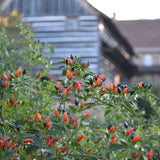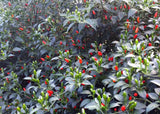Willing's Barbados Pepper
Capsicum annuum
Likely native to Yucatan and Central America, this pepper is said to have traveled to Barbados in the seventeenth century. This attractive, prolific small hot pepper grows wild there and is a classic ingredient in the local cuisine. In the late summer through fall it is covered with tiny, upward facing peppers which are dark green, turning bright orange and red as they ripen.
The plant was given to John Bartram in the 1760s by Charles Willing, twice mayor of Philadelphia, for plant collector Sir John St. Clair’s special collection of tropical plants in Trenton, New Jersey. At this time, it was introduced into cultivation in Philadelphia as an ornamental houseplant.
According to Dr. William Woys Weaver in Heirloom Vegetable Gardening: "The peppers were also harvested, either green or ripe, and infused in Madeira to make pepper wine, or as some called it, "pepper sherry." This was a popular Caribbean condiment in old Philadelphia and Charleston cookery, particularly as a seasoning for soups, sauces, and fricassees."
Also known as Barberry or Pipperidge pepper in historic Philadelphia.
Photos courtesy of Old Salem Museums & Gardens.
Days to maturity: 70-80
Seeds per pack: 25
Germination rate: 88% on 11/18/2024
Planting / harvesting notes
Sow indoors two months early and transplant into garden soil when its 70-80
degrees, in Philadelphia, that’s mid-May. Grow in full sun in regular garden soil. Will self sow.
Seed keeping notes
Peppers are generally self-pollinating, though we isolate different varieties of the same species by at least 50 feet, in hopes that flying insects will not cross pollinate them unexpectedly. There are several important species of peppers, so check your scientific names! This pepper is Capsicum annuum. Pepper seeds are ripe when the fruits have turned their final fiery color - in this case, fiery-orange. Cut the fruit, scrape out seeds, and lay them out to dry on a labeled screen or paper product in a ventilated place away from direct sunlight for a week or two. Consider wearing gloves for your protection! Drying the peppers before seed extraction can slightly lower your germination rates, but works fine for home seed saving as long as the peppers do not rot.







